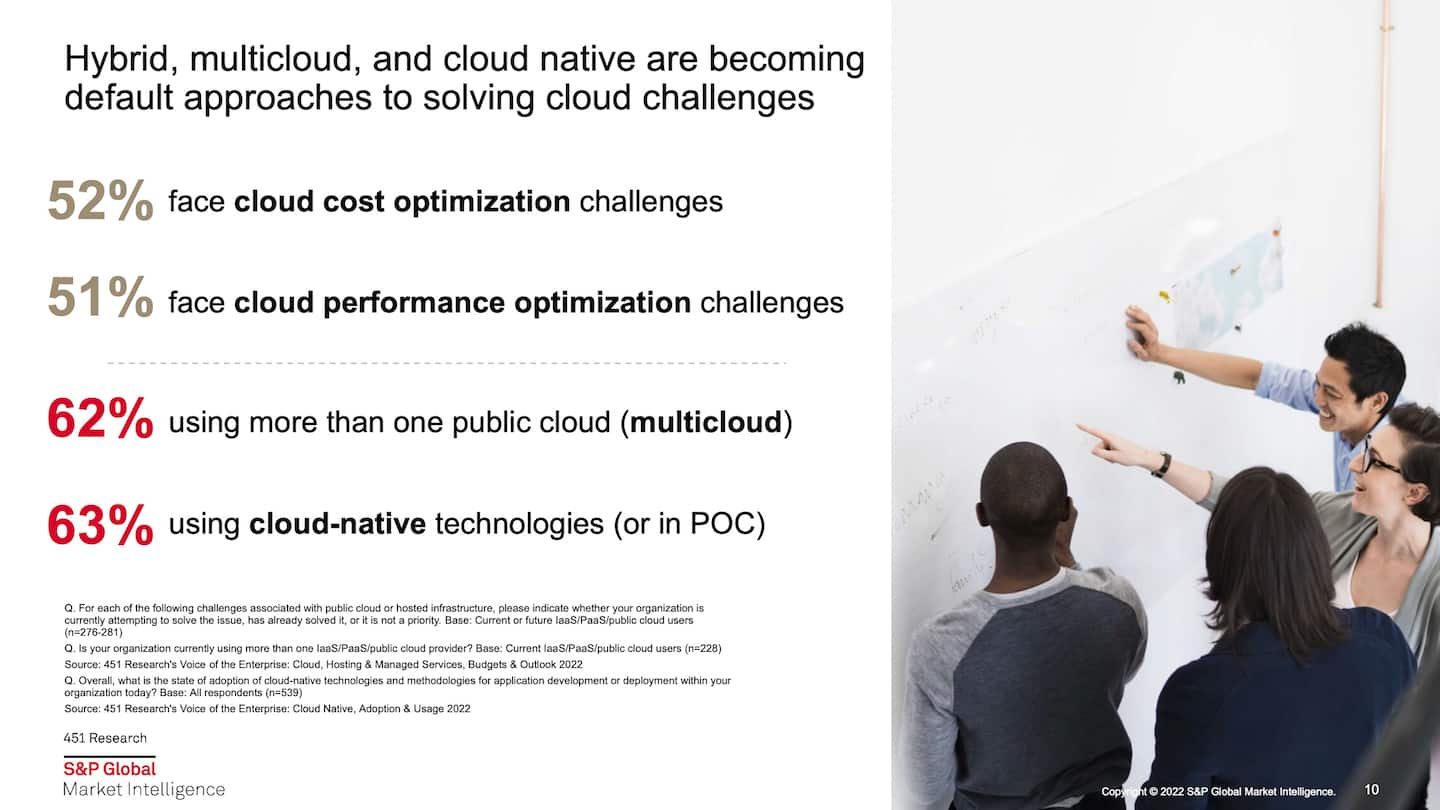Not Every Cloud Is Meant for Every Workload

Multicloud is maturing at the enterprise level. At our recent cloud webinar, Not Every Cloud Is Meant for Every Workload, nearly 80% of event respondents were using more than one cloud, and 50% were using three or more clouds.
Understanding which cloud platforms are the best fit for which workloads can maximize your return on investment (ROI) and your customers’ output. To learn more about how companies use cloud computing today, 451 Research conducted a survey to determine the market conditions and trends among enterprise cloud users. Here are some of the key insights.
Digital transformation is ubiquitous
The research presented by Liam Eagle, Research Director and Head of Voice of the Enterprise and Voice of the Service Provider for 451 Research, which is part of S&P Global Market Intelligence, makes it clear that the enterprise isn’t just moving to the cloud; it’s already there:
- 93% of survey respondents said they are at least considering a strategy for digital transformation
- 53% are actively executing such a strategy today
Among the survey respondents involved in application modernization, 37% describe the effort as “large” and 24% describe it as “very large.”
“The research that we conduct consistently reinforces this idea that digital transformation and application modernization are universal imperatives at enterprises,” said Liam.
Using and choosing technologies

Fig. 1: The factors driving application modernization
When it comes to modernization, why companies are doing it is just as important as what they’re using to do it (Figure 1). Among those surveyed, Liam said, the main objectives for digital transformation included:
- Modernizing workloads
- Improving performance
- Creating and improving efficiency
- Reducing costs

Fig. 2: Primary workload execution venues
One of the key shifts to come out of the research is the steady decline in businesses that are mostly doing things on-premises in legacy environments, with a corresponding increase in businesses who are primarily using public cloud infrastructure for those workloads.
Meanwhile, there was consistency among companies that are primarily executing software as a service (SaaS) in a more modern on-premises environment (Figure 2).
What makes companies hesitate on multicloud
Although there is a movement from what Liam called “multicloud by happenstance” — more on that shortly — to “multicloud by design,” some companies still see barriers to modernization (Figure 3).

Fig. 3: The top five barriers to greater use of the cloud
Liam said that, while cloud has the potential to resolve all of those issues, it doesn’t necessarily do so out of the box (Figure 4).
“Cloud comes with complexities, and embracing cloud means confronting those complexities for organizations,” he said. Still, the research showed “pretty universal adoption of cloud and, more broadly, cloud-operating models.”

Fig. 4: Cloud complexities faced by organizations
Backing into multicloud
Akamai Vice President for Cloud, Larry Alston, elaborated on Liam’s observation, noting that some companies that could be considered early adopters of multicloud didn’t adopt intentionally. They also didn’t realize they were pioneering workload shopping.
“Five, six, seven years ago,” said Larry, “people had multicloud because departments started using different kinds of clouds for their applications, and they kind of backed into multicloud strategy.”
Factors in choosing a cloud strategy today
Although adoption is more deliberate today, the factors that businesses are considering would be familiar to those early pioneers. Companies consider their cloud strategy through a number of different lenses based on specific needs:
- Cost
- Latency
- Location
- Scale
- Performance
For example, Larry explained, a company might look at the Akamai cloud as a fit for portable workloads that need compute in remote locations around the globe: test harnesses, end-user testing, frameworks that put a load on systems, transcoding, API distribution, and enterprise applications — in other words, for companies that reach a scale at which they are distributing compute power and data storage across regions to be closer to end users.
Use case: transcoding
Pavel Despot, an enterprise cloud specialist at Akamai, recently worked with a customer whose video workflow had very specific requirements to meet their user experience key performance indicator (KPI) goals. The answer was a distributed transcoding workflow that could respond to and manage fluctuating workload demand and volume.
Transcoding was an ideal fit for distributed multicloud, Pavel said, because it is both critical to performance and, as a result, is best deployed geographically close to the event. Luckily, the workflows are also easily automatable, so deploying them when and where they're needed isn't a challenge; doing so, instead of relying on a SaaS or on-premises solution gives you the flexibility to cost effectively address fluctuations in demand and day-to-day workloads.
Essential for a media delivery workload
“The point of transcoding is to take the extremely high-quality 4K video and translate it into something our devices can actually use,” said Pavel. “Different devices have different capabilities. If you try to send a multi-terabyte file to your phone, you're going to have slow sorts, rebuffers, all the things that drive your users away.”
It’s why transcoding is so essential for a media delivery workload.
Necessary for quality
“That’s where the CDN comes in,” said Pavel. “You give the transcoded videos to your CDN so it can work with the user's device to figure out what the best version of the video is so they can watch it. The transcoding is really important to keep users engaged because it’s necessary to get them a quality video stream.”
And transcoding, he added, isn’t all that different from what Akamai does for other customers in FinServ, banking, and ecommerce.
“It’s a workload — you need use and storage. It’s bursty; it’s time-sensitive; it’s tightly coupled to the edge; and it’s CPU- and data-intensive.”
In other words, it’s the epitome of a workload that benefits from being shopped to the right cloud.
Learn more about how to effectively “workload shop”
To hear the full discussion, please watch the on-demand webinar.


